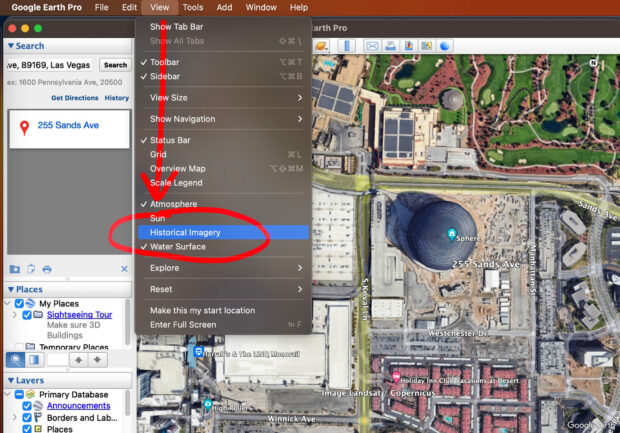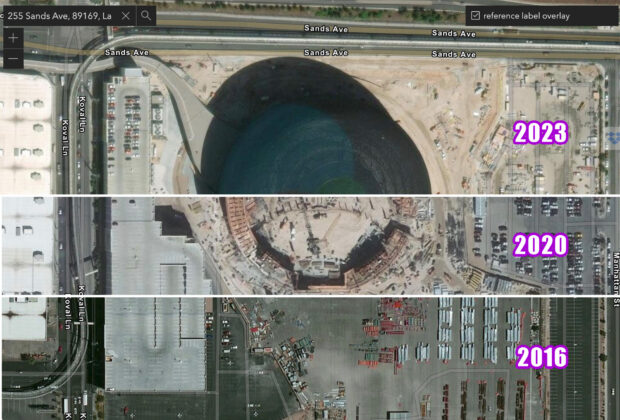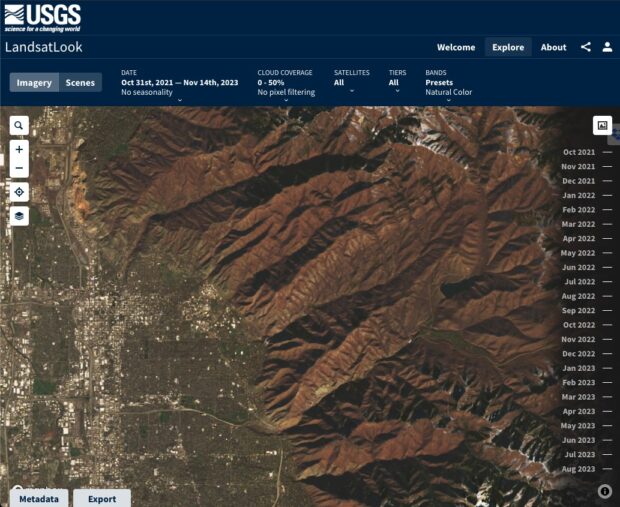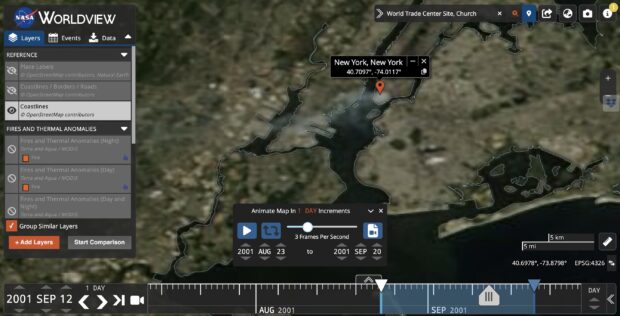Have you ever wondered what your childhood home or school looked like 20 years ago? Or wished you could see an aerial view of a city as it appeared decades in the past? Thanks to all the old satellite images available online, you can easily travel back in time and explore vintage bird’s-eye views of just about anywhere in the world.
Here are some some free tools that let you browse old historical satellite photos with just a few clicks. So hop aboard our virtual time machine as we take a fascinating journey into the geospatial past!
Google Earth Pro
Google Earth makes viewing historical satellite imagery easy with its interactive time slider. To get started, you will need to download the free Google Earth Pro desktop app for Mac or Windows. Sorry, the ability to browse old satellite images is not an available using your web browser.
After you install the desktop app, just click on the View menu and select Historical Imagery. You’ll be able to see distinct satellite images from different years using the date slider.

The amount of historical imagery available varies by location, but many densely populated areas have regular captures dating back to the mid-1980s. So, whether you want to relive memories of your old neighborhood or watch decades of urban growth, Google Earth makes it easy to find historical aerial photos
Esri’s Living Atlas Of The World
Esri’s Living Atlas of the World is an expansive collection of geographic information. From weather data to demographics, this interactive map provides insights into how natural and human forces shape our ever-changing planet.
With the launch of their new Wayback imagery tool (link), you can now travel back in time through their archive of vintage aerial photos. Although it’s still in the early stages, the Esri Wayback tool lets you rewind anywhere from a few years to a decade. Expect to see its historical imagery library grow rapidly in the coming years.

With tested Esri’s Wayback historical satellite image tool by looking up the Las Vegas Sphere and watching it transform from a parking lot in 2016 to the giant landmark that it became in 2023.
USGS LandSatLook
Managed by the U.S. Geological Survey, LandSatLook provides quick access to satellite images of large areas. You can’t zoom down to a house level, so this tool is best for just analyzing cities or neighborhoods.

Its archive of Landsat and Sentinel-2 data lets you scan Earth’s surface to analyze environmental changes. With an easy-to-use interface, you can filter by date range, cloud cover percentage, and other criteria to refine your historical image search.
LandLook also generates animations that bring timelapse views to life as animated GIFs. After finding a location, click the “Export” tab in the bottom left. For more advanced analysis, you can even download scenes as GeoTIFFs and import them into GIS software.
NASA Worldview
NASA‘s satellite imagery platform, Worldview, offers global views with full resolution. While it doesn’t have extensive archives, Worldview lets you rewind back to the early 2000s for some data sets. By adjusting the time slider, you can compare near real-time images with snapshots from the past few days or weeks.
With international satellite networks like Aqua, Terra, and Suomi NPP, Worldview captures our dynamic Earth multiple times per day. Turn back the clock to watch weather systems form, fires burn, floods arise, and other short-term changes.
In the example below, we navigated to the World Trade Center on September 11, 2001, and was able to see the smoke from the tragic terrorist attack.

NASA Worldview lacks the deep street-level historic imagery of other tools but provides an unmatched near-real-time perspective.
Planet
Founded by ex-NASA scientists, Planet operates the world’s largest constellation of Earth imaging satellites. Their fleet of over 200 miniature CubeSats satellites captures the entire land surface every day at 3-5 meter resolution. Planet’s daily global imagery powers real-time monitoring solutions for agriculture, disaster response, and more.
Through their online platform, anyone can access their archive of photos reaching back over a decade. While Planet’s free satellite imagery is limited to samples, you can purchase full-resolution historical scenes for in-depth analysis. So if you need regular high-res views going back to 2009, Planet provides unmatched coverage powered by their unique CubeSat tech.
Open Aerial Map (OAM)
This article is about how to access old satellite images, but we are adding one drone image platform to the list.
Open Aerial Map (OAM) is a community-driven, open source mapping project focused on curating and sharing aerial drone imagery. Launched in 2017, OAM has grown to become one of the leading open source mapping platforms globally.
Although aerial drone images lack the large coverage area of satellite images, they provide higher image resolutions for smaller areas.

The OAM platform contains new and existing drone imagery from a variety of sources and locations around the world. All images contributed are made freely available through the easy-to-use OAM interface. Users can browse and search the imagery, which comes with detailed metadata like provider, sensor type, resolution, file size, location coordinates, and more.
By bringing together a global community to contribute drone imagery, OAM has become a valuable open data resource for various applications in just a few short years. The collaborative approach is key to the project’s rapid growth and success.
Peering Into The Past With Old Satellite Images
Geospatial technology offers an incredible window into the past. Whether out of personal nostalgia, scientific analysis, or historical curiosity, satellite imagery unlocks an exciting perspective of our world.
Next time you feel sentimental for childhood places or want to study environmental change, go take one of these old satellite image viewers for a spin. From your hometown to famous landmarks across the globe, you can explore our planet through the decades from your computer. You’re sure to gain a renewed appreciation for the ever-changing Earth we call home as you digitally uncover the past from orbit.

Frank Wilson is a retired teacher with over 30 years of combined experience in the education, small business technology, and real estate business. He now blogs as a hobby and spends most days tinkering with old computers. Wilson is passionate about tech, enjoys fishing, and loves drinking beer.






















 X Blocked By Brazil As Feud With Elon Musk Escalates
X Blocked By Brazil As Feud With Elon Musk Escalates
Leave a Reply
You must be logged in to post a comment.